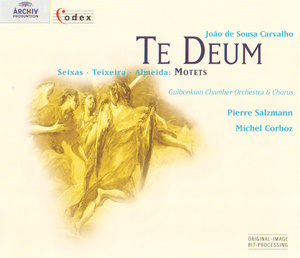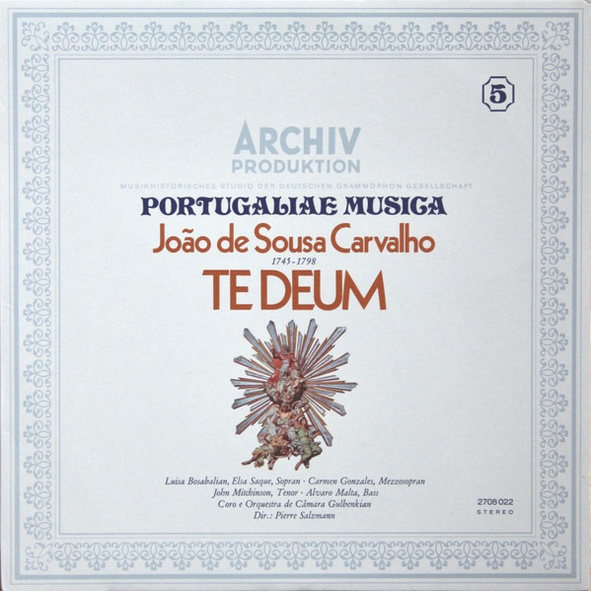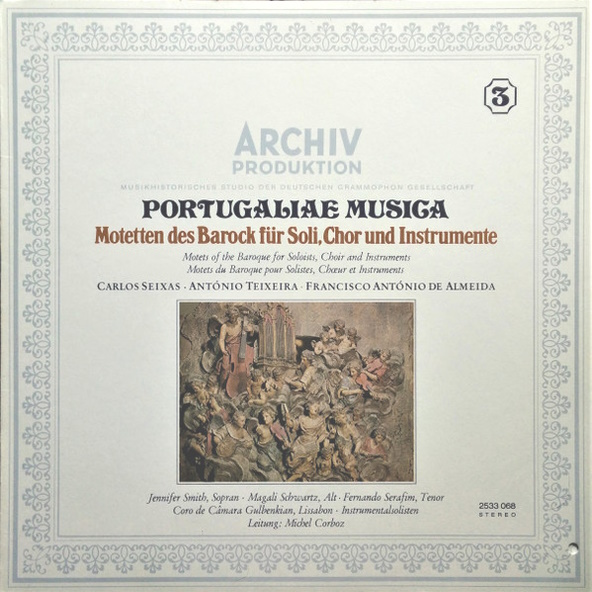 |
|
2 CD -
453 182-2 - (p) 1996
|
|
| 50
Jahre (1947-1997) - Codex II Serie -
4/5 |
|
|
|
|
|
|
|
|
| João de Sousa
CARVALHO (1745-1798) |
|
|
|
|
TE
DEUM für 5 Solostimmen, 2 Chöre
und Orchester
|
|
|
95' 18" |
|
-
1. Ouvertüre für 2 Orchester -
(Larghetto · Allegro con spirito)
|
Orch. I: 2 Fl., 2 Cor., 2
Fg., V. I/II, Vc., Cb., Cemb. | Orch II: 2 Ob., 2 Tr., V.
I/II, Va., Vc., Cb., Org.
|
9' 10" |
|
1 - 1 |
-
2. O salutaris Hostia - (Largo ·
Allegro con spirito)
|
Chor
I/II (je à 4: Sopran. Alt, Tenor,
Baß); 2 Ob., 2 Fg., 2 Tr., 2 Cor.,
V. I/II, Va., Vc., Cb., Org. |
5' 29" |
|
1 - 2 |
-
3. Te Deum laudamus - (Allegro con
spirito)
|
Chor
I/II (je à 4: S., A., T., B.); 2
Ob., 2 Tr., 2 Trb., V. I/II, Va.,
Vc., Cb., Org.
|
2' 36" |
|
1 - 3 |
-
4. Tibi omnes Angeli - (Allegro)
|
Sopran-Solo;
2 Ob., 2 Tr., V. I/II, Va., Vc.,
Cb., Cemb. |
6' 47" |
|
1 - 4 |
-
5. Sanctus - (Allegro con spirito)
|
Chor
I/II (je à 4: S., A., T., B.); 2
Fl., 2 Tr., V. I/II, Va., Vc., Cb.,
Org. |
2' 59" |
|
1 - 5 |
| -
6. Te gloriosus Aspostolorum chorus
- (Andante) |
Sopran-,
Mezzosopran-, Baß-Solo; 2 Ob., 2
Cor., V. I/II, Va., Vc., Cb., Cemb.
|
8' 17" |
|
1 - 6 |
-
7. Patrem immensae majestatis -
(Allegro con spirito)
|
Chor
I/II (je à 4: S., A., T., B.); 2
Ob., 2 Tr., V. I/II, Va., Vc., Cb.,
Org. |
2' 47" |
|
1 - 7 |
-
8. Sanctum quoque - (Larghetto)
|
Mezzosopran-Solo;
2 Fl., 2 Cor., 2 Fg., V. I/II, Va.,
Vc., Cb., Cemb. |
6' 31" |
|
1 - 8 |
-
9. Tu Patris sempiternus - (Allegro)
|
Sopran-Solo,
Chor I/II (je à 4: S., A., T., B.);
2 Ob., 2 Tr., 2 Trb., 2 Fg., V.
I/II, Va., Vc., Cb., Cemb. |
7' 46" |
|
1 - 9 |
-
10. Tu devicto - (Allegro moderato)
|
Tenor-Solo;
2 Fl., 2 Fg., 2 Cor., V. I/II, Va.,
Vc., Cb., Cemb. |
8' 31" |
|
1 - 10 |
-
11. Judex crederis - (Allegro con
spirito)
|
Chor
I/II (je à 4: S., A., T., B.); 2
Ob., 2 Tr., 2 Cor., 2 Fg., V. I/II,
Va., Vc., Cb., Org. |
3' 21" |
|
1 - 11 |
| -
12. Te ergo quaesumus - (Larghetto) |
Sopran-Solo,
Chor I/II (je à 4: S., A., T., b.);
2 Fl., 2 Fg., V. I/II, Va., Vc.,
Cb., Cemb. |
3' 54" |
|
1 - 12 |
-
13. Salvum fac - (Allegro)
|
Sopran
I/II-, Mezzosopran-, Tenor-,
Baß-Solo, 2 Trb., V. I/II, Va., Vc.,
Cb., Cemb. |
7' 41" |
|
2 - 1 |
-
14. Per singulos dies - (Allegro
assai)
|
Chor
I/II (je à 4: S., A., T., B.); 2
Ob., 2 Tr., 2 Cor., V. I/II, Va.,
Vc., Cb., Org. |
3' 00" |
|
2 - 2 |
-
15. Dignare, Domine - (Largo)
|
Sopran-Solo,
2 Fl., 2 Fg., 2 Cor., V. I/II, Va.,
Vc., Cb., Cemb. |
7' 00" |
|
2 - 3
|
-
16. Fiat misericordia - (Allegro con
spirito · Fuga · Pi# stretto)
|
Chor
I/II (je à 4: S., A., T., B.); 2
Fl., 2 Ob., 2 Fg., 2 Cor., 2 Tr., 2
Trb., V. I/II, Va., Vc., Cb., Org. |
5' 50" |
|
2 - 4
|
-
17. Tantum ergo - (Largo · Allegro)
|
Chor
(à 4: S., A., T., B.); 2 Ob., 2 Fg.,
2 Cor., V. I/II, Va., Vc., Cb., Org. |
2' 52" |
|
2 - 5
|
|
|
|
|
|
| Carlos de SEIXAS
(1704-1752) |
|
|
|
|
Ardebat
Vincentius (Responsorio Quinto
in festa de S. Vincente)
|
|
|
6' 07" |
2 - 6
|
-
Ardebat Vincentius - (Grave) | Sed
maior illum - (Allegro)
|
Chor I/II (je à
4: S., A., T., B.), Continuo
(Orgel; im Allegro: Cembalo,
Gambe) |
|
|
|
-
Intrepidus Dei athleta - (Tempo
giusto; Verso a Duo)
|
Sopran-Solo,
Alt-Solo, Continuo (Cembalo,
Gambe)
|
|
|
|
-
Sed maior illum - (Allegro da capo)
|
Chor I/II (je à
4: S., A., T., B.), Continuo
(Orgel, Cembalo) |
|
|
|
Tantum
ergo - (Adagio)
|
Chor (S., A.,
T., B), Continuo (Orgel)
|
|
3' 19" |
2 - 7
|
|
|
|
|
|
| António TEIXEIRA
(1707 - after 1759) |
|
|
|
|
Gaudete,
astra (Moteto per ogni tempo)
|
|
|
12' 12" |
|
-
1. Rezitativ: "Gaudete, astra"
|
Tenor-Solo,
Continuo (Cembalo, Gambe) |
1' 06" |
|
2 - 8
|
-
2. Arie: "In vallibus ad fontes" -
(Adagio)
|
Sopran-Solo, 2
Violinen, Continuo (Cembalo,
Gambe) |
3' 35" |
|
2 - 9 |
-
3. Rezitativ: "Refulsit alma lux"
|
Tenor-Solo,
Continuo (Cembalo, Gambe) |
0' 58" |
|
2 - 10 |
-
4. Arie: "Aura infida" - (Andante)
|
Sopran-Solo, 2
Violinen, Continuo (Cembalo,
Gambe) |
6' 33" |
|
2 - 11 |
|
|
|
|
|
| Francisco António de
ALMEIDA (c.1702 - after 1755) |
|
|
|
|
| O
quam suavis |
|
|
8' 16" |
|
| - 1. O quam
suavia - (Largo) || Qui ut
dulcedinem tuam - (Andante).
|
Sopran-Solo,
Alt-Solo, Chor (S., A., T., B.),
Continuo (Orgel) |
3' 51" |
|
2 - 12 |
-
2. Pane suavissimo - (Adagio)
|
Sopran-Solo,
Alt-Solo, Tenor-Solo, Continuo
(Orgel)
|
1' 21" |
|
CD2 - 13 |
| -
3. Esurientes - (Andante) |
Chor (S., A.,
T., B.), Continuo (Orgel) |
1' 58" |
|
CD2 - 14 |
| -
4. Alleluia - (Allegro) |
Chor (S., A.,
T., B.), Continuo (Orgel) |
4' 03" |
|
CD2 - 15 |
Beatus
vir
|
|
|
10' 22" |
|
| -
1. Beatur vir |
Sopran-Solo,
Chor (S., A., T., B.), Continuo
(Cembalo, Gambe; in Chorpatien:
Orgel) |
3' 11" |
|
CD2 - 16 |
-
2. Exortum est
|
Tenor-Solo,
Continuo (Cembalo, Gambe) |
1' 26" |
|
CD2 - 17 |
| -
3. Jucundus homo |
Sopran-Solo,
Chor (S., A., T., B.), Continuo
(Cembalo, Gambe; in Chorpatien:
Orgel) |
3' 55" |
|
CD2 - 18 |
| -
4. Gloria Patri - Sicut erat |
Tenor-Solo,
Continuo (Cembalo, Gambe) | Sopran-Solo,
Chor (S., A., T., B.),
Cont. (Cembalo, Gambe;
in Chorpatien: Orgel) |
1' 48" |
|
CD2 - 19 |
|
|
|
|
Carvalho
Luisa
Bosabalian, Sopran
Elsa Saque, Sopran
Carmen Gonzales, Mezzosopran
John
Mitchinson, Tenor
Alvaro Malta, Bass
CORO E ORQUESTRA DE CÂMARA
GULBENKIAN
Cremilde Rosado Fernandes, Cembalo
Antoine Sibertin-Blanc, Orgel
Pierre SALZMAN, Leitung
|
Seixas, Teixeira,
Almeida
Jennifer
Smith, Sopran
Magali Schwartz, Alt
Fernando Serafim, Tenor
CORO DE CÂMARA
GULBENKIAN
John Calabrese, Violine I
Manuel Teixeria Ferreira, Violine
II
Pierre Salemann, Orgel
Cremilde Rosado Fernandes, Cembalo,
Orgel
Maria de Macedo, Gambe
Michel
CORBOZ, Leitung
|
|
|
Quellen
(Sources):
Carvalho: Manuskript (1791),
Biblioteca Nacional de Lisboa, Refa.
351 dos Reservados (Critical revision
according to the source and
preparation of the basso continuo:
Pierre Salzmann).
Seixas: Manuskript im Archiv
der Kathedrale von Lissabon.
Teixeira: Manuskript in der
Bibliothek des Grafen von Schönhorn in
Wiesentheid.
Almeida: Manuskript im Archiv
der Kathedrale von Lissabon und in der
Privatsammlung F. de Sousa.
|
|
|
|
|
Luogo
e data di registrazione |
|
Auditorium der
Gulbenkian-Stiftung, Lisbona
(Portogallo):
- 16-24 giugno 1970 | (Carvalho)
- 19-21 giugno 1970 | (Seixas,
Teixeira, Almeida)
|
|
|
Original
Editions |
|
- Archiv
Produktion | 2708 022 | 2 LP |
(p) 1971 | ANA | (Carvalho)
- Archiv Produktion | 2533 068 |
1 LP | (p) 1971 | ANA | (Seixas,
Teixeira, Almeida) |
|
|
Edizione
"Codex"
|
|
Archiv
Produktion "Codex" | 453 182-2 |
durata 68' 46" · 67' 31" | LC 0113
| 2 CD | (p) 1996 | ADD | stereo
|
|
|
Executive
Producer |
|
Dr. Gerd
Ploebsch (Te Deum), Hans Tutz
|
|
|
Recording
Producer |
|
Dr.
Gerd Ploebsch
|
|
|
Tonmeister
(Balance Engineer) |
|
Hansjoachim
Reiser
|
|
|
Recording
Engineer
|
|
Gernot
Westhäuser
|
|
|
Cover |
|
El
Greco, "The Dream of Philip II"
(detail), Madrid, Escorial
|
|
|
Art Direction
|
|
Fred
Münzmaier
|
|
|
Note |
|
Original-Image-Bit-Processing
- Added presence and brilliance,
greater spatial definition |
|
|
|
|
|
ORIGINAL
EDITIONS

2 LP - 2708 022 - (p) 1971

1 LP - 2533 068 - (p) 1971
|
Treasures
from Archiv Produktion’s
Catalogue
A rare and valuable collection of
documents is the pride of any
library or archive. CODEX, Archiv
Produktion’s new series, presents
rare documents in sound from 50
years of pioneering recording.
These recordings have been
digitally remastered using
original-image bit-processing
technology and can now be
appreciated in all the richness of
their original sound-image. They
range from the serene counterpoint
of a Machaut, the intensely
spiritual polyphony of a Victoria,
to the imposing state-music of a
Handel.
For the artists on Archiv
Produktion recordings, a constant
aim has been to rediscover the
musical pulse of past times and to
recreate the spirit of past ages.
In this sense each performance
here - whether by Pro Musica
Antiqua of Brussels in the 1950s,
the Regensburg Domchor in the
1960s, or Kenneth Gilbert and
Trevor Pinnock in the 1970s - made
a vital contribution to the
revival of Early Music in our
time.
CODEX highlights recordings that
were unique in their day, many of
them first recordings ever of this
rare and remarkable repertoire,
now appearing for the first time on
CD. A special aspect of the
history of performance in our
century can now be revisited, as
great moments from Archiv
Produktion’s recording history are
restored and experienced afresh.
Dr.
Peter Czornyi
Director,
Archiv Produktion
CARVALHO: TE DEUM |
Almeida - Teixeira - Seixas:
Motets
When opera was introduced into
portugal at the beginning of the
18th century it led to a decline
in sacred polyphonic music and an
increase in instrumental music,
just as had occured in other parts
of Europe. The Portuguese Baroque
and Rococo generated new forms of
musical expression, new ideas and
new patterns - all conditioned by
the cultural, geographical, social
and political situation of the
country. Following the current
international fashion at the time,
music became Italianate in its
form and theatrical appeal; even
sacred compositions adhered to
this manner, thus reflecting the
course of the Italian tradition.
All the influences, however, were
not able to efface the original
character of a native musical
expression, wich can still be
traced in ceertain melodic idioms
and in the particular harmonic
qualities of much 18th-century
Portuguese music.
João
de Sousa Carvalho was born in
Estremoz (Alentejo) on 22
February, 1745, and died in
Alentejo in 1798. He began
studying music in the Colégio dos
Santos Reis in Vila Viçosa, and
showed so much talent that at the
age of 16 he set off for Italy,
sent by the Seminário Patriarchal
of Lisbon. On 15 January 1761 he
began his studies in the
Sant'Onofrio in Naples, where
Carlo Cotumacci was his teacher.
On his return to Portugal in 1767,
Carvalho was appointed professor
of counterpoint in the Seminário
Patriarchal, where he later served
as mestre (1769-73) amd mestre
de capela (1773-98). Quite
apart from his work as a composer,
Carvalho was a
distinguished teacher. Among his
pupils were António Leal Moreira,
Marcos Portugal and Domingos
Bomtempo.
Carvalho’s vast production
includes 14 operas that were
written and performed between 1769
and 1789. He also wrote two masses
and fice psalm settings for mixed
choir and organ, a Credo (1767)
and three settings of the Te
Deum (1769, 1789 and 1792
respectively). In addition, he
composed mani "toccatas" for the
harpsichord.
The Te Deum of 1792,
recordded here, is for five
soloists, double choir and
orchestra. It has 16 sections,
together with an overture. It was
presumably composed for a ceremony
in 1792 in the Royal Chapel Nossa
Senhora da Ajuda in Lisbon part of
a liturgical service sung before
the blessing. This Te Deum
is unusual in that it begins and
ends with motets, O salutaris
hostia and Tantum ergo,
respectively. In liturgical
practice the Te Deum
originally took the form of a
recitative with a choral
melody for one voice sung in
alternating parts; later on
individual verses were arranged
with several voices for these
alternating pairs. Carvalho’s Te
Deum conforms with the
latter practice. An ambitious
work, the 1792 Te Deum is
the composer's musical testament,
for it includes, in a developed
and heightened form, all the
characteristics of his writing,
his style and his musical
language. It is spectacular in its
manner and theatrical in its
expression; and yet it is a
sincere act of faith, deeply
religious. From the very start of
the overture for two orchestras,
we can appreciate the great
originality and the ability of
this composer. The the two
orchestras alternate, contrast
with or complement each other;
presented in various instrumental
and soloistic blocks, they take on
a dialoguing role in the various
sections that form the structure
of the work, The magnificent
texture of the “Fiat
Misericordia”, which comes near
the end, surely marks the summit
of Carvalho's art..
FRANCISCO ANTÓNIO DE ALMEIDA was
one of the most important of
Portugual’s Baroque composers. As
a recipient of a royal stipend
from King João V, he studied for
some years in Rome (c. 1720-26),
where, apart from other works, he
gave the first performances of his
oratorios Il pmtimento di
Davidde (1722) and Giuditta
(1726). As maestro of the Lisbon
Patriarchal Cathedral he wrote
numerous sacred vocal works, for
soloists, chorus and organ,
including a mass for eight voices,
an eight-voice Veni Sancte
Spiritus with organ, a Good
Friday Lamentation, the Mirerere,
a litany, St. Anthony matins, and
a number of beautiful motets, such
as the Beatus wir and O
quam suavis on this
recording. The American scholar
Robert Stevenson has written of
them that “both testify to
Almeida’s genius at catching in
soaring contrapuntal lines the
expressive qualities of the text”.
Of equal importance to Almeida is
ANTÓNIO TEIXEIRA. He too studied
for some years in Rome (c.
1717-28), also the beneficiary of a
royal grant from João V. After his
return to Lisbon he worked as
diocesan examiner in plainchant
and was a chaplain singer in the
Lisbon Patriarchal Cathedral.
Little of Teixeira’s extensive
œuvre is known today. It included
a 20-voice Te Deum (1734),
seven operas, psalm settings,
Lamentations and motets with and
without instruments. Teixeira’s
expressive abilities are well
illustrated in the motet Gaudete,
astra, for soprano and
tenor, two violins and continuo in
which, despite an evident tendency
towards the Italian style,
personal lyrical elements are
unmistakable, both in the melodic
lines and in the colourful
harmony.
CARLOS DE SEIXAS, a contemporary
of Almeida and Teixeira, was,
together with them, the creator of
Baroque music in Portugal. The son
of the cathedral organist in
Coimbra, he moved to Lisbon in
1720 and obtained the coveted
position of organist at the royal
chapel, which he held for the rest
of his life. The greater part of
his surviving output consists of
music for keyboard, but he also
wrote some orchestral works and
sacred music. Only a few motets
survive today; there is now no
trace of his ten masses with
orchestra, or the Te Deum
for four choirs, mentioned in
18th-century dictionaries. Much
was probably destroyed in the
earthquake of 1755. In the
responsory Ardebat Vincentius
Seixas proves himself to be a
master of contrapuntal and vocal
technique, with a strong sense of
rhythm.
(Based
on note: by Filipe de Sousa,
1971)
|
|
|
|